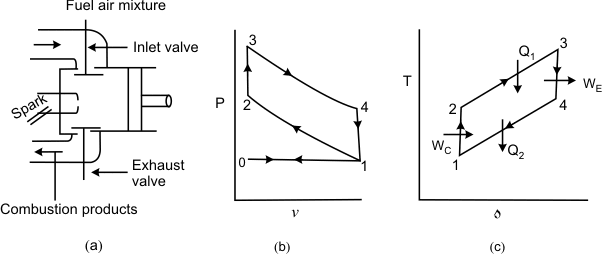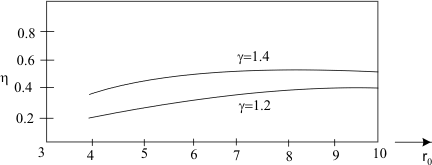Air Standard Otto Cycle
The Air Standard Otto cycle is named after its inventor Nikolaus A. Otto . Figures 29.1 (a), (b) and (c) illustrate the working principles of an Otto cycle. The Otto cycle consists of the following processes.

Figure 29.1
0-1: Constant pressure suction during which a mixture of fuel vapour and air is drawn into the cylinder as the piston executes an outward stroke.
1-2: The mixture is compressed isentropically due to the inward motion of the piston. Because of the isentropic compression , the temperature of the gas increases.
2-3: The hot fuel vapour-air mixture is ignited by means of an electric spark. Since the combustion is instantaneous, there is not enough time for the piston o move outward. This process is approximated as a constant volume energy addition process .
3-4: The hot combustion products undergo isentropic expansion and the piston executes an outward motion.
4-1: The exhaust port opens and the combustion products are exhausted into the atmosphere. The process is conveniently approximated as a constant-volume energy rejection process.
1-0: The remaining combustion products are exhausted by an inward motion of the piston at constant pressure.
Effectively there are four strokes in the cycle. These are suction, compression, expression, and exhaust strokes, respectively. From the P-V diagram it can be observed that the work done during the process 0-1 is exactly balanced by the work done during 1-0. Hence for the purpose of thermodynamic analysis we need to consider only the cycle 1-2-3-4, which is air-standard Otto Cycle.
 |
(29.1) |
Where  and and  denote the energy absorbed and energy rejected in the form of heat. Application of the first law of thermodynamics to process 2-3 and 4-1 gives: denote the energy absorbed and energy rejected in the form of heat. Application of the first law of thermodynamics to process 2-3 and 4-1 gives:
 |
(29.2) |
 |
(29.3) |
Therefore,
 |
(29.4) |
1-2 and 3-4 are isentropic processes for which  constant constant
Therefore,
 |
(29.5) |
and
 |
(29.6) |
But
 and and  |
(29.7) |
Hence
 |
(29.8) |
So,
 or or  |
(29.9) |
  |
(29.10) |
or
and
 |
(29.12) |
 |
(29.13) |
Where
 Compression ratio Compression ratio |
(29.14) |
Since  , the efficiency of the Otto cycle increases with increasing compression ratio. However, in an actual engine, the compression ratio can not be increased indefinitely since higher compression ratios give higher values of , the efficiency of the Otto cycle increases with increasing compression ratio. However, in an actual engine, the compression ratio can not be increased indefinitely since higher compression ratios give higher values of  and this leads to spontaneous and uncontrolled combustion of the gasoline-air mixture in the cylinder. Such a condition is usually called knocking. and this leads to spontaneous and uncontrolled combustion of the gasoline-air mixture in the cylinder. Such a condition is usually called knocking.

Figure 29.2
Performance of an engine is evaluated in terms of the efficiency (see Figure 29.2). However, sometime it is convenient to describe the performance in terms of mean effective pressure, an imaginary pressure obtained by equating the cycle work to the work evaluated by the following the relation
 |
(29.15) |
The mean effective pressure is defined as the net work divided by the displacement volume.
That is
 |
(29.16) |
|